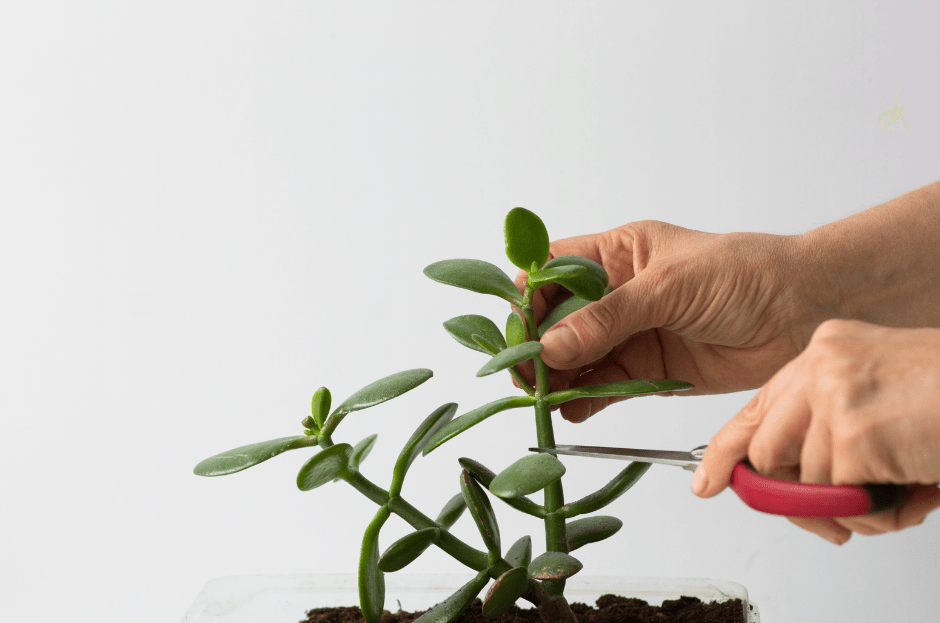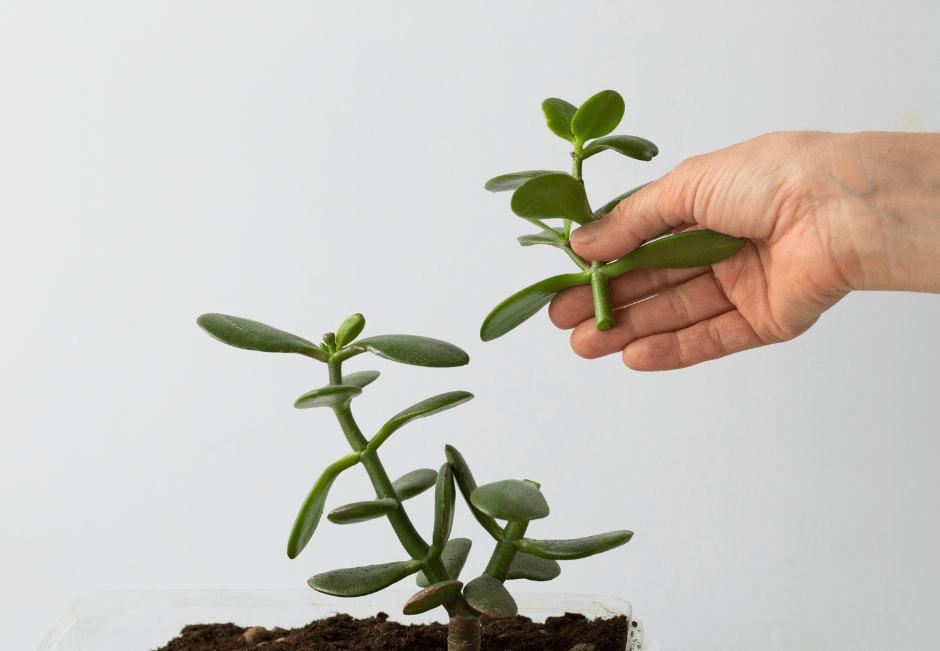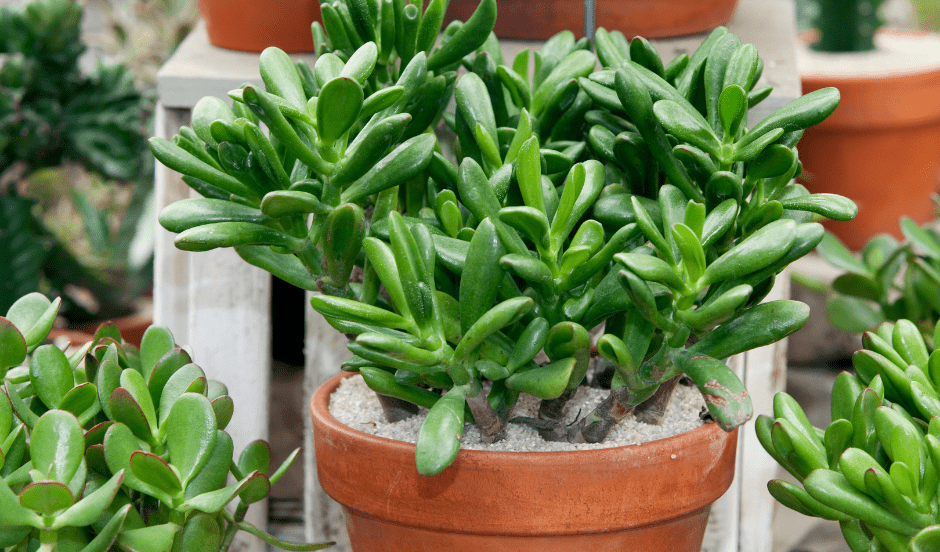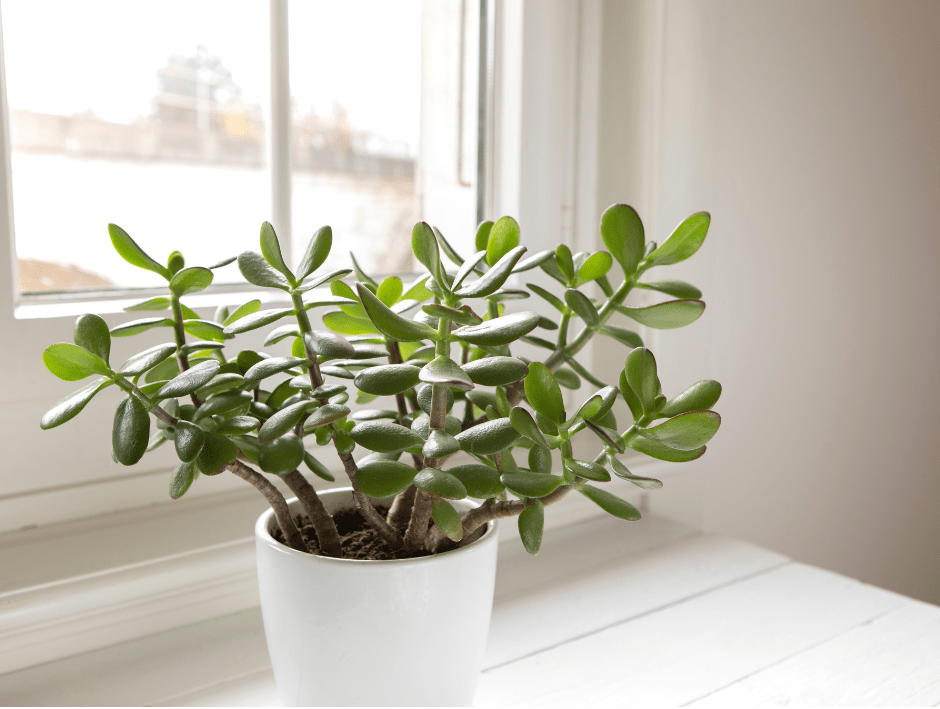Here are some quick tips on how to take care of a jade plant:
- Requires bright indirect sunlight.
- Keep the soil moist but not wet. Water once a month during the winters
- Requires loose well-draining soil. Preferably succulent potting mix
- Fertilize once during the growing season
Jade plants are one of the most popular and easy-to-grow succulents in the world everybody said. However, I killed mine by overwatering it and providing with little sunlight. Everybody in the local nurseries sold it as an indoor plant and i kept it indoors giving minimal sunlight. I was a beginner plant parent. Little did I know that they have thick, fleshy leaves that store water and cannot survive in low-light conditions. Here are some basic jade plant care tips you can do so that jades can thrive and look their absolute best.

Requirements on How to take care of a Jade Plant
- Light: Jade plants need at least 4 hours of direct sunlight per day, preferably in the morning or afternoon. Avoid exposing them to harsh midday sun, which can scorch their leaves. If you grow jade plants indoors, place them near a bright window or supplement with artificial light.
- Temperature: Jade plants prefer moderate temperatures, between 18°C and 24°C. They can tolerate colder temperatures, down to 10°C, but they will go dormant and stop growing. Avoid exposing them to frost, which can damage their leaves and stems.
- Water: Jade plants are drought-tolerant and can go for long periods without water. However, they still need regular watering during their active growing season, which is spring and summer. Water them thoroughly when the top 2-3 cm of soil feels dry, and let the excess water drain out. Do not overwater them, as this can cause root rot and fungal infections. Reduce watering in winter, when the plants are dormant.
- Soil: Jade plants need well-draining soil that does not retain too much moisture. Read it again “that does not retain moisture”. I have had my jade plant growing really well in garden soil for almost 3 years. It was out growing and I decided to repot and use a regular potting mix that retains moisture. And after a month my good old jade got root rot. Your regular garden soil with perlite and a little of coco peat works well for jade plants.+
- Fertilizer: Jade plants do not need much fertilizer, as they can get most of the nutrients they need from the soil. However, you can apply a balanced liquid fertilizer, diluted to half-strength, once a month during the growing season. Avoid fertilizing in winter, when the plants are dormant.
Where to Grow Jade Plants
Jade plants can be grown both indoors and outdoors, depending on your climate and preference. If you have south, east or west facing balconies or windows, you can grow jade plants indoors, where they can get ample amounts of indirect bright light. Since my store is located facing west side, we get alot of afternoon sunlight that is warm and hot.
However, If you have north facing balconies, you can grow jade plants outdoors in your balcony, where you can give jade plants very bright light. My house has only north facing balconies and windows, therefore I keep my jade plant outdoors in my north facing balcony. If you are planning to keep indoors invest in artificial lights, such as fluorescent or LED lamps, to supplement the natural light.

How to Plant Jade Plants
Jade plants are easy to plant and establish, whether you start from seeds, cuttings, or offsets. Here are the steps to follow for each method:
- Seeds: You can buy jade plant seeds online or from a local nursery. To sow them, fill a shallow tray or pot with moist, well-draining soil. Sprinkle the seeds evenly over the surface, and cover them lightly with a thin layer of soil. Place the tray or pot in a warm and bright location, but out of direct sunlight. Keep the soil moist, but not soggy, until the seeds germinate, which can take 2-4 weeks. Once the seedlings have two pairs of leaves, you can transplant them into individual pots or containers.
- Cuttings: You can take cuttings from a healthy jade plant at any time of the year, but spring and summer are the best seasons. In my case taking cuttings have been the most successful. To take a cutting, use a sharp and sterile knife or scissors to cut a stem or a leaf from the parent plant. Make sure the cutting is at least 5 cm long, and has several nodes (the points where leaves emerge). Let the cutting dry for a few days, until a callus forms over the cut end. This will prevent infection and rotting. Then, insert the cutting into moist, well-draining soil, with the callus facing down. Place the pot in a bright and warm location, but out of direct sunlight. Water the cutting sparingly, until it roots, which can take 2-4 weeks. You can check for roots by gently tugging on the cutting. If it resists, it means it has rooted. Once the cutting has rooted, you can treat it as a mature jade plant.
- Offsets: Offsets are small plants that grow from the base or the stem of a mature jade plant. They are also known as pups or babies. To propagate jade plants from offsets, you can either leave them attached to the parent plant, or separate them carefully. If you choose to separate them, use a sharp and sterile knife or scissors to cut them off, making sure to include some roots. Let the offsets dry for a few days, until a callus forms over the cut end. Then, plant them in moist, well-draining soil, and place them in a bright and warm location, but out of direct sunlight. Water them sparingly, until they establish, which can take 2-4 weeks. Once the offsets have established, you can treat them as mature jade plants.
- Leaves: Gently pluck a healthy leaf from the parent jade plant. Twist it lightly to remove it.Let the base of the leaf air dry for two to three days to form a callus. Insert the dried leaf into moist, sandy soil at a 30-degree angle, burying just the cut end.Water the soil sparingly to avoid overhydration. Roots should develop within a few weeks, and a new plant will emerge from the base of the leaf.

How to Water Jade Plants
Watering is one of the most crucial aspects of jade plant care, as it can affect their health and appearance. Jade plants are succulents, which means they store water in their leaves and stems, and can survive in dry conditions. However, they still need regular watering during their active growing season, which is spring and summer. The key is to water them thoroughly, but infrequently, and to let the soil dry out between watering’s.
To water jade plants, you can use a watering can, a hose, or a drip irrigation system. Make sure the water is at room temperature, and free of chlorine and fluoride, which can harm the plants. Water the plants until the water drains out of the drainage holes at the bottom of the pot or container. Do not let the plants sit in water, as this can cause root rot and fungal infections. Discard any excess water that collects in the saucer or tray.
To know when to water jade plants, you can use your finger, a moisture meter, or a wooden stick. Insert your finger, the moisture meter, or the skewer into the soil, up to 2-3 cm deep. If the soil feels dry, it is time to water. If the soil feels moist, wait until it dries out. You can also observe the leaves of the jade plant, as they can indicate the water level. If the leaves are plump and shiny, it means the plant is well-hydrated. If the leaves are wrinkled and dull, it means the plant is thirsty.
Watering frequency depends on several factors, such as the size of the pot, the type of soil, the temperature, the humidity, and the light. Generally, jade plants need watering once every 7-10 days in summer, and once every 2-4 weeks in winter. However, you should always check the soil before watering, and adjust accordingly.
How to Feed Jade Plants
Jade plants do not need much fertilizer, as they can get most of the nutrients they need from the soil. However, you can apply a balanced liquid fertilizer, diluted to half-strength, once a month during the growing season. This will help the plants grow faster and healthier, and produce more flowers and leaves. Avoid fertilizing in winter, when the plants are dormant, as this can cause them to grow leggy and weak.
To fertilize jade plants, you can use any general-purpose or succulent-specific fertilizer, as long as it has a balanced ratio of nitrogen, phosphorus, and potassium (N-P-K), such as 10-10-10 or 19-19-19. You can also use organic fertilizers, such as compost left over tea leaves, vermi compost or leaf compost or just throw away some black coffee, which are rich in micronutrients and beneficial bacteria. However, be careful not to over-fertilize, as this can burn the roots and leaves, and make the plants more susceptible to pests and diseases.
To apply fertilizer, you can either mix it with water and pour it over the soil, or spray it on the leaves. I use an npk 19-19-19 as a foliar spray once a month. I also use seaweed granules diluted in water and pour over the soil away from the roots. I use the npk and seaweed each month with an interval of 10 days in between. Do not use the npk and seaweed at the same time. Make sure to water the plants well before and after fertilizing, to prevent salt buildup and nutrient imbalance. You can also flush the soil with water every few months, to wash away any excess fertilizer and salts.

How to Prune Jade Plants
Pruning is another important aspect of jade plant care, as it can improve their shape, size, and health. Jade plants are fast-growing and can become leggy and top-heavy, especially if they do not receive enough light. Pruning can help them maintain a compact and bushy form, and encourage branching and flowering. Pruning can also remove any dead, damaged, or diseased parts, and prevent the spread of pests and diseases.
To prune jade plants, you can use a sharp and sterile pair of scissors, pruning shears, or a knife. You can prune them at any time of the year, but spring and summer are the best seasons, as the plants will heal faster and produce new growth.
How to repot a jade plant
Jade plants do not need to be repotted very often, as they have a shallow and compact root system, and can adapt to small pots or containers. However, you may need to repot your jade plant if it becomes root-bound, if the soil becomes too compacted or depleted, or if you want to change the pot or container for aesthetic reasons. The best time to repot a jade plant is in spring or summer, when the plant is actively growing.

To repot a jade plant, you will need a new pot or container that is slightly larger than the current one, and has drainage holes at the bottom. You will also need fresh, well-draining soil, and some tools, such as a trowel, a knife, and a brush. Here are the steps to follow:
- Water the jade plant well a few days before repotting, to make the soil and roots easier to work with.
- Gently remove the jade plant from the current pot or container, by turning it upside down and tapping on the bottom. You may need to use a knife to loosen the soil around the edges, if it is too tight.
- Inspect the roots for any signs of damage, disease, or rot without removing or messing with the old soil. Trim off any dead, diseased, or rotten roots with a sharp and sterile knife. You can also prune some of the healthy roots, if they are too long or thick, to encourage new growth.
- Fill the new pot or container with some fresh, well-draining soil. You can use the same soil mix as the current one.You can also add some organic matter, such as compost or peat moss, to improve the soil structure and fertility.
- Place the jade plant in the center of the new pot or container, and spread the roots evenly. Make sure the plant is at the same depth as before, and not too deep or too shallow.
- Fill the rest of the pot or container with soil, and gently press it around the roots. Leave some space at the top, for watering and air circulation.
- Water the jade plant lightly, and let the excess water drain out. Do not water again until the soil feels dry, as the plant needs some time to adjust to the new pot or container.
- Place the jade plant in a bright and warm location, but out of direct sunlight, for a few weeks. This will help the plant recover from the repotting stress, and establish in the new pot or container.
Types of jade plants
Jade plants belong to the genus Crassula, which contains over 200 species of succulents. The most common and popular type of jade plant is Crassula ovata, also known as money plant, lucky plant, or friendship plant. This type has oval-shaped, glossy green leaves, and produces small, star-shaped, white or pink flowers in winter.
However, there are many other types of jade plants, with different shapes, sizes, colors, and features. Some of the most popular ones are:
- Crassula arborescens: Also known as silver jade plant, this type has round, flat, silvery-blue leaves, with red edges. It grows up to 2 meters tall, and produces clusters of white or pink flowers in winter.
- Crassula ovata ‘Gollum’: Also known as finger jade plant, this type has tubular, green leaves, with red tips. It grows up to 1 meter tall, and produces small, star-shaped, white or pink flowers in winter.
- Crassula ovata ‘Hummel’s Sunset’: Also known as golden jade plant, this type has oval-shaped, green leaves, with yellow and red margins. It grows up to 1 meter tall, and produces small, star-shaped, white or pink flowers in winter.
- Crassula ovata ‘Variegata’: Also known as variegated jade plant, this type has oval-shaped, green leaves, with white and yellow streaks. It grows up to 1 meter tall, and produces small, star-shaped, white or pink flowers in winter.
- Crassula ovata ‘Crosby’s Compact’: Also known as dwarf jade plant, this type has oval-shaped, dark green leaves, with red edges. It grows up to 30 cm tall, and produces small, star-shaped, white or pink flowers in winter.
- Crassula perforata: Also known as string of buttons, this type has triangular, green leaves, with red edges, that are stacked along the stem. It grows up to 60 cm tall, and produces small, star-shaped, white or pink flowers in summer.
- Crassula tetragona: Also known as miniature pine tree, this type has needle-like, green leaves, that grow along the stem. It grows up to 1.5 meters tall, and produces small, star-shaped, white or pink flowers in summer.
These are just some of the many types of jade plants that you can grow and enjoy.

